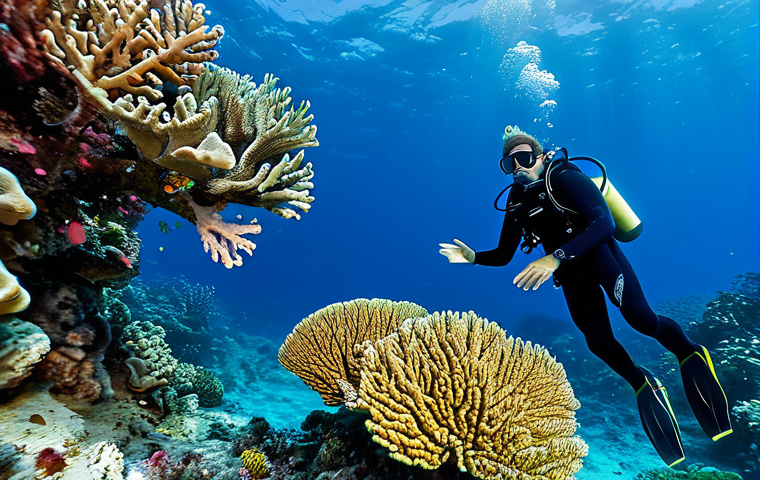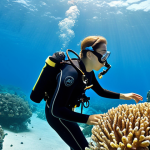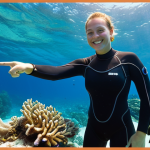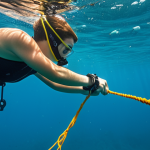The ocean holds a magic that few truly understand until they’re immersed in it. For those of us who’ve turned that passion into a profession, there’s a unique joy in guiding others, especially when you’re mentoring future diving instructors.
I’ve personally witnessed moments where aspiring divemasters, initially hesitant, blossom into remarkably confident and inspiring leaders, ready to share the underwater world responsibly.
It’s more than just teaching skills; it’s about cultivating a deep understanding and love for the marine environment, reflecting the evolving trends in eco-conscious diving and personalized instruction.
We’re living in a time where the dive industry values not just technical prowess, but also empathy and adaptive teaching methods, crucial for success in a world increasingly reliant on digital learning tools and global travel.
Seeing these transformations, the sheer grit and dedication unfold, truly makes every effort worthwhile. How do these exceptional individuals rise above?
Let’s delve deeper into these inspiring journeys.
The ocean holds a magic that few truly understand until they’re immersed in it. For those of us who’ve turned that passion into a profession, there’s a unique joy in guiding others, especially when you’re mentoring future diving instructors.
I’ve personally witnessed moments where aspiring divemasters, initially hesitant, blossom into remarkably confident and inspiring leaders, ready to share the underwater world responsibly.
It’s more than just teaching skills; it’s about cultivating a deep understanding and love for the marine environment, reflecting the evolving trends in eco-conscious diving and personalized instruction.
We’re living in a time where the dive industry values not just technical prowess, but also empathy and adaptive teaching methods, crucial for success in a world increasingly reliant on digital learning tools and global travel.
Seeing these transformations, the sheer grit and dedication unfold, truly makes every effort worthwhile. How do these exceptional individuals rise above?
Let’s delve deeper into these inspiring journeys.
Mastering the Art of Connection: Beyond the Manual

1. Cultivating Empathy and Understanding
One of the most profound lessons I’ve learned over my years as a dive professional is that teaching isn’t just about regurgitating information from a manual.
It’s about connecting with your students on a human level, understanding their fears, their anxieties, and their individual learning styles. I remember a particularly challenging student, Sarah, who had a deep-seated fear of enclosed spaces.
The standard approach simply wasn’t working. Instead of pushing her, I took the time to talk, to listen, and to truly empathize with her apprehension.
We broke down the confined space exercises into tiny, manageable steps, celebrating every micro-victory. This wasn’t in any textbook, but it was what Sarah needed.
It’s this personalized, empathetic approach that truly sets a phenomenal instructor apart. You see their eyes light up when they finally grasp a concept, or when they overcome a personal hurdle, and that’s a feeling you simply can’t bottle.
It reinforces my belief that the human element is paramount in education, especially in an environment as unique and sometimes intimidating as the underwater world.
It’s about building trust, fostering a safe space, and demonstrating that you truly care about their journey, not just their certification. This kind of deep connection encourages students to open up, ask questions, and ultimately, become more confident and capable divers.
It extends beyond the training sessions, often leading to lifelong friendships and a strong sense of community within the diving world.
2. The Power of Storytelling in Instruction
Think about the best teachers you’ve ever had. Chances are, they weren’t just reciting facts; they were weaving narratives. In diving, this translates into bringing the underwater world to life even before students dip their fins.
Instead of just stating the procedure for buoyancy control, I often share a story about a time I watched a seahorse perfectly hover, demonstrating absolute mastery over its movements, and then relate that to how they can achieve similar grace.
Or, when discussing safety protocols, I might recount a real-life scenario (with privacy in mind, of course) where proper planning saved the day. These aren’t just dry instructions; they’re vivid examples that stick in the mind, making complex concepts more relatable and memorable.
When I’m mentoring new instructors, I always emphasize that their personal experiences are their most valuable teaching aids. Share your passion, your awe, your funny mishaps, and even your moments of challenge.
It makes you relatable, authentic, and incredibly engaging. Students don’t just learn skills; they absorb your love for the ocean, your respect for its creatures, and your commitment to safety, all through the lens of your own unique journey.
This storytelling component isn’t just about entertainment; it’s a powerful mnemonic device, etching critical information into their long-term memory in a way that bullet points simply can’t.
It’s what makes the learning experience not just educational, but truly transformative.
Navigating the Evolving Landscape: Technology and Global Reach
1. Embracing Digital Tools for Enhanced Learning
The dive industry, like every other, has been irrevocably shaped by technology. Gone are the days when a flip chart and a projector were considered cutting-edge.
Now, aspiring instructors must be adept at leveraging digital platforms, from online learning management systems to interactive dive planning apps. I’ve witnessed firsthand how a well-integrated digital component can significantly enhance a student’s pre-course preparation, freeing up valuable in-water time for practical skills.
For instance, using virtual reality simulations for emergency scenarios or augmented reality overlays to demonstrate equipment assembly can make complex procedures less intimidating before a student even touches the water.
When mentoring, I push my instructors to think beyond traditional classroom walls. How can they use video debriefs to pinpoint areas for improvement? Can a shared online document help track progress and provide instant feedback?
The potential is immense, but it requires a willingness to adapt and experiment. It’s not just about consuming technology; it’s about strategically integrating it to create a richer, more efficient, and ultimately more effective learning experience.
I remember one instructor, initially resistant to using tablets for dive planning, saw her student engagement soar once she started using a popular dive computer app in class.
It truly opened her eyes to the possibilities, and now she champions digital integration.
2. Cultivating a Global Mindset in Instruction
Today’s dive students come from every corner of the globe, bringing with them diverse cultural backgrounds, learning preferences, and expectations. A truly successful dive instructor must possess a global mindset, capable of adapting their teaching style to resonate with a truly international audience.
This isn’t just about language; it’s about understanding subtle cultural nuances, respecting different communication styles, and being aware of varied prior experiences.
For example, some cultures might prefer more direct feedback, while others thrive with a more indirect, encouraging approach. I’ve found that being open to learning from my students’ perspectives enriches my own teaching significantly.
It’s also about understanding international dive standards and being able to contextualize them for different regulatory environments. A top instructor isn’t just teaching skills; they’re fostering a sense of global community and shared passion for the ocean.
It means being mindful of things like local currency variations when discussing equipment costs or understanding the unique challenges of diving in different marine environments across continents.
This global perspective makes an instructor more versatile, more sought-after, and ultimately, more impactful in a world where dive travel is more accessible than ever.
It’s a continuous learning process, a fascinating journey of discovery that goes far beyond the practical skills of diving itself.
The Bedrock of Trust: Safety, Ethics, and Environmental Stewardship
1. Instilling an Unwavering Commitment to Safety
If there’s one non-negotiable aspect of dive instruction, it’s safety. Period. As an instructor, you are not just teaching someone to breathe underwater; you are literally holding their lives in your hands.
This immense responsibility demands an unwavering commitment to safety protocols, emergency procedures, and preventative measures. I’ve seen instructors who cut corners, and it always, always leads to problems.
My philosophy, and what I instill in every mentee, is that safety isn’t a checklist; it’s a mindset. It’s about being hyper-vigilant, constantly assessing risk, and never, ever becoming complacent.
This means not just teaching the PADI or SSI safety drills, but truly imbuing students with a deep respect for the ocean’s power and their own limitations.
It’s about meticulous equipment checks, thorough pre-dive briefings, and knowing when to call a dive. I remember a time when a student hesitated during an open water session due to an ear issue they hadn’t mentioned.
My immediate instinct, honed over years, was to pause the dive, assess the situation, and prioritize their well-being, even if it meant rescheduling. That decision built immense trust and reinforced the paramount importance of safety.
It’s in these moments that an instructor truly earns their stripes, demonstrating not just technical competence, but an inherent, almost visceral, dedication to safeguarding their students.
2. Championing Environmental Stewardship and Ethical Practices
The underwater world is our classroom, our office, our playground. It is therefore our profound responsibility to protect it. A truly exceptional dive instructor doesn’t just teach people to dive; they teach them to dive responsibly, ethically, and with an inherent respect for the marine environment.
This means incorporating environmental awareness into every lesson – from proper finning techniques to avoid disturbing delicate coral, to understanding the impact of sunscreen on marine life, and advocating for sustainable dive practices.
I’ve personally seen how a single, passionate instructor can transform a group of casual divers into vocal ocean advocates. It’s about leading by example: always bringing a mesh bag for rogue plastic, participating in cleanups, and educating divers on local marine regulations.
It’s a part of EEAT – demonstrating expertise and authority not just in diving, but in conservation. My commitment to ethical behavior also extends to fair business practices and transparent communication with students.
You build trust by being honest, reliable, and by putting the student’s best interests first, always. This isn’t just good for the planet; it’s good for business and essential for building a lasting, reputable career in the dive industry.
| Key Trait | Description for Dive Instructor Success | Impact on Students & Industry |
|---|---|---|
| Empathy & Patience | Ability to understand and address individual student fears, learning paces, and cultural backgrounds. | Increases student comfort, confidence, and retention; fosters a positive learning environment. |
| Adaptability & Innovation | Willingness to integrate new technologies (e.g., e-learning, VR) and tailor teaching methods. | Enhances learning efficiency, caters to diverse student needs, keeps the curriculum fresh and engaging. |
| Unwavering Safety Focus | Prioritizing safety protocols, emergency preparedness, and risk assessment above all else. | Builds immense trust, prevents incidents, establishes a reputation for reliability and professionalism. |
| Environmental Stewardship | Active promotion of responsible diving practices and marine conservation. | Educates eco-conscious divers, contributes to ocean health, enhances the instructor’s authority and credibility. |
| Strong Communication Skills | Clear, concise, and engaging verbal and non-verbal communication, including storytelling. | Improves comprehension, retention of information, and overall student satisfaction. |
| Business Acumen | Understanding marketing, customer service, and financial management within the dive sector. | Ensures sustainability and growth of their professional career; attracts and retains clients effectively. |
Cultivating a Thriving Dive Community: Beyond Certification
1. Fostering Lifelong Engagement and Passion
Getting a student certified is a significant milestone, but a truly great instructor understands that it’s just the beginning of their journey. The real magic happens when you inspire them to stay engaged, to continue learning, and to become active members of the dive community.
I’ve always believed that my role extends beyond the final sign-off. It’s about igniting a lifelong passion for the underwater world. This often means organizing regular fun dives, skill refreshers, or even specialized workshops that go beyond recreational limits, like underwater photography or marine identification.
When I mentor new instructors, I emphasize the importance of creating a welcoming, inclusive atmosphere that makes divers feel like they belong. It’s not just about “selling” more courses; it’s about genuinely wanting to see people continue to explore and enjoy diving safely.
I’ve seen this strategy pay dividends in student loyalty and word-of-mouth referrals. People remember how you made them feel, and if you inspire them to fall deeply in love with diving, they’ll not only stick with it, but they’ll also become your most enthusiastic advocates.
It’s a rewarding cycle of passion, learning, and connection that builds strong, lasting relationships within the dive world.
2. Mentorship and Continuous Professional Development
The journey to becoming a successful dive instructor doesn’t end with getting your own certification. In fact, that’s where the real learning truly begins.
I’ve found that the best instructors are perpetual students themselves, always seeking out new knowledge, refining their skills, and staying abreast of the latest industry trends and teaching methodologies.
For me, this means regularly attending workshops, getting specialized training (like technical diving or rebreather instruction), and actively seeking feedback from peers and even students.
When I mentor, I encourage this same hunger for continuous improvement. It’s about developing a robust personal development plan that includes not just technical skills, but also soft skills like communication, leadership, and even business management.
The dive industry is dynamic, with new equipment, techniques, and environmental challenges emerging constantly. An instructor who rests on their laurels quickly becomes outdated.
I push my mentees to embrace new challenges, to step outside their comfort zone, and to always view themselves as works in progress. This commitment to ongoing learning not only enhances their expertise and credibility (EEAT in action!) but also ensures they can provide the most relevant and highest quality instruction to their own students, keeping them at the forefront of the profession.
The Business of Passion: Sustaining a Professional Dive Career
1. Developing a Robust Personal Brand and Marketing Strategy
Being an exceptional instructor is one thing; making a living from it is another. In today’s competitive landscape, every professional dive instructor needs to understand the fundamentals of building a personal brand and executing a savvy marketing strategy.
This isn’t about being overtly salesy; it’s about effectively communicating your unique value proposition. What sets you apart? Is it your specialty in underwater photography, your unique approach to teaching children, or your passion for marine conservation?
I’ve advised countless aspiring instructors on the importance of a professional online presence – a well-maintained website, engaging social media content showcasing their adventures and expertise, and positive online reviews.
Word-of-mouth is still king in this industry, but digital visibility amplifies it exponentially. It’s about crafting a narrative around your passion that resonates with potential students and dive centers.
I remember one instructor I mentored, initially shy about self-promotion, who transformed her career by simply sharing more about her unique travel experiences and eco-diving philosophy online.
Her authentic voice attracted exactly the kind of students she wanted, proving that genuine passion, effectively communicated, is the most powerful marketing tool of all.
2. Financial Acumen and Sustainable Practices
A sustainable dive career isn’t just about endless passion; it’s also about smart financial management. Many instructors I’ve met are brilliant in the water but struggle with the business side.
Understanding how to price courses, manage expenses, budget for equipment maintenance, and even plan for seasonal fluctuations are critical skills. This also extends to understanding the monetization strategies of the industry, such as how AdSense placement on a blog can generate passive income, or how affiliate marketing with dive gear retailers can supplement your income.
My advice is always to treat your instruction like a serious small business, even if you’re working freelance. This means tracking income and expenses meticulously, setting clear financial goals, and investing in yourself through continued education and professional development.
It also involves being transparent with students about costs and value, ensuring fair pricing that reflects your expertise and the quality of your instruction.
A financially sound instructor is a stable instructor, capable of investing in better equipment, pursuing further training, and ultimately, providing a superior experience for their students without burning out.
It’s a holistic approach to building a career that is both personally fulfilling and financially viable, ensuring that your passion can indeed be your profession for the long haul.
Concluding Thoughts
As I reflect on decades spent beneath the waves, guiding countless individuals to discover the magic of diving, it’s clear that true mastery in this profession extends far beyond technical skills. It’s about heart, adaptability, and an unshakeable commitment to the ocean itself. What truly sets an instructor apart is their ability to inspire, to connect, and to foster a community of passionate, responsible ocean stewards. The journey is continuous, demanding growth in every aspect, from digital prowess to environmental advocacy. Embrace this evolving landscape, and you won’t just teach diving; you’ll shape lives and safeguard our precious underwater world for generations to come.
Useful Information
1. Seek Mentorship Actively: Don’t just rely on official courses. Find experienced instructors whose teaching style you admire and seek their guidance. A good mentor is invaluable for accelerating your growth and refining your approach.
2. Embrace Digital Tools: Invest time in learning online platforms, dive planning apps, and video editing for debriefs. Technology can significantly enhance your teaching efficiency, student engagement, and reach.
3. Prioritize Safety First, Always: Never compromise on safety. Continuously refresh your emergency skills and risk assessment. Your students’ well-being is your paramount responsibility and the bedrock of your professional reputation.
4. Become an Ocean Advocate: Integrate environmental stewardship into every lesson. Teach students about marine conservation, responsible diving practices, and lead by example through your own actions and advocacy.
5. Develop Business Acumen: Understand how to brand yourself, market effectively, and manage your finances. Treating your instruction as a professional small business ensures long-term sustainability and allows you to continue pursuing your passion.
Key Takeaways
Becoming a successful dive instructor is a multifaceted journey that blends deep passion with practical professionalism. Key pillars include empathetic teaching, technological adaptation, an unwavering commitment to safety, and strong environmental ethics. Building a robust personal brand and understanding financial management are crucial for a sustainable career. Ultimately, it’s about fostering a lifelong love for the ocean while constantly evolving as an educator and steward.
Frequently Asked Questions (FAQ) 📖
Q: What’s the biggest payoff you’ve experienced in guiding someone from a tentative divemaster student to a confident instructor?
A: Honestly, it’s not just one thing, but if I had to pick, it’s witnessing that moment when the ‘light bulb’ truly goes on. I’ve seen so many aspiring divemasters, initially a bit wobbly, suddenly click into place.
They stop just doing the skills and start understanding the art of teaching, feeling the responsibility, and really falling deeply in love with the ocean – not just as a playground, but as something to protect.
That transformation, seeing someone you’ve mentored not just get certified, but genuinely blossom into a leader who’s passionate about safety and conservation?
That’s gold. It’s like watching a fragile coral bud grow into a vibrant reef, and knowing you played a small part in nurturing it.
Q: With all the talk about eco-conscious diving and digital tools, how do you see the dive industry evolving, and what does that mean for new instructors entering the field?
A: Oh, it’s shifted massively, and for the better, I think. Back in the day, it felt like it was all about demonstrating perfect skills. Now, while technical prowess is still non-negotiable, there’s a much stronger emphasis on empathy, on being truly adaptive to different learning styles, and crucially, on instilling a deep sense of environmental stewardship.
It’s not just about getting people underwater anymore; it’s about making them ambassadors for the marine world. And yes, digital learning and global connectivity have really reshaped how we train and where we find our students.
New instructors have to be incredibly versatile – not just great divers, but also engaging educators, tech-savvy communicators, and passionate advocates for the ocean.
It’s a dynamic, exciting time to be involved, but it demands more than just knowing your knots.
Q: You mentioned the “sheer grit and dedication” of those who excel. What specific qualities truly set apart those exceptional individuals who rise to become inspiring dive leaders?
A: That’s a great question, and it’s something I ponder often. It’s definitely more than just natural talent or picking up skills quickly. The ones who truly excel, the ones who make you proud, they possess an incredible resilience.
They don’t just learn from mistakes; they embrace them as opportunities to grow. There’s a genuine curiosity about the ocean that goes beyond the classroom, a true passion for understanding marine life and ecosystems.
And importantly, they have this quiet, unwavering commitment to their students’ success and safety, even when things get tough. It’s that blend of technical mastery, deep personal connection to the ocean, and an almost instinctive ability to inspire trust and confidence in others.
It’s not something you can just teach; it’s woven into their very being, polished through countless hours, often in challenging conditions.
📚 References
Wikipedia Encyclopedia
구글 검색 결과
구글 검색 결과
구글 검색 결과
구글 검색 결과
구글 검색 결과






